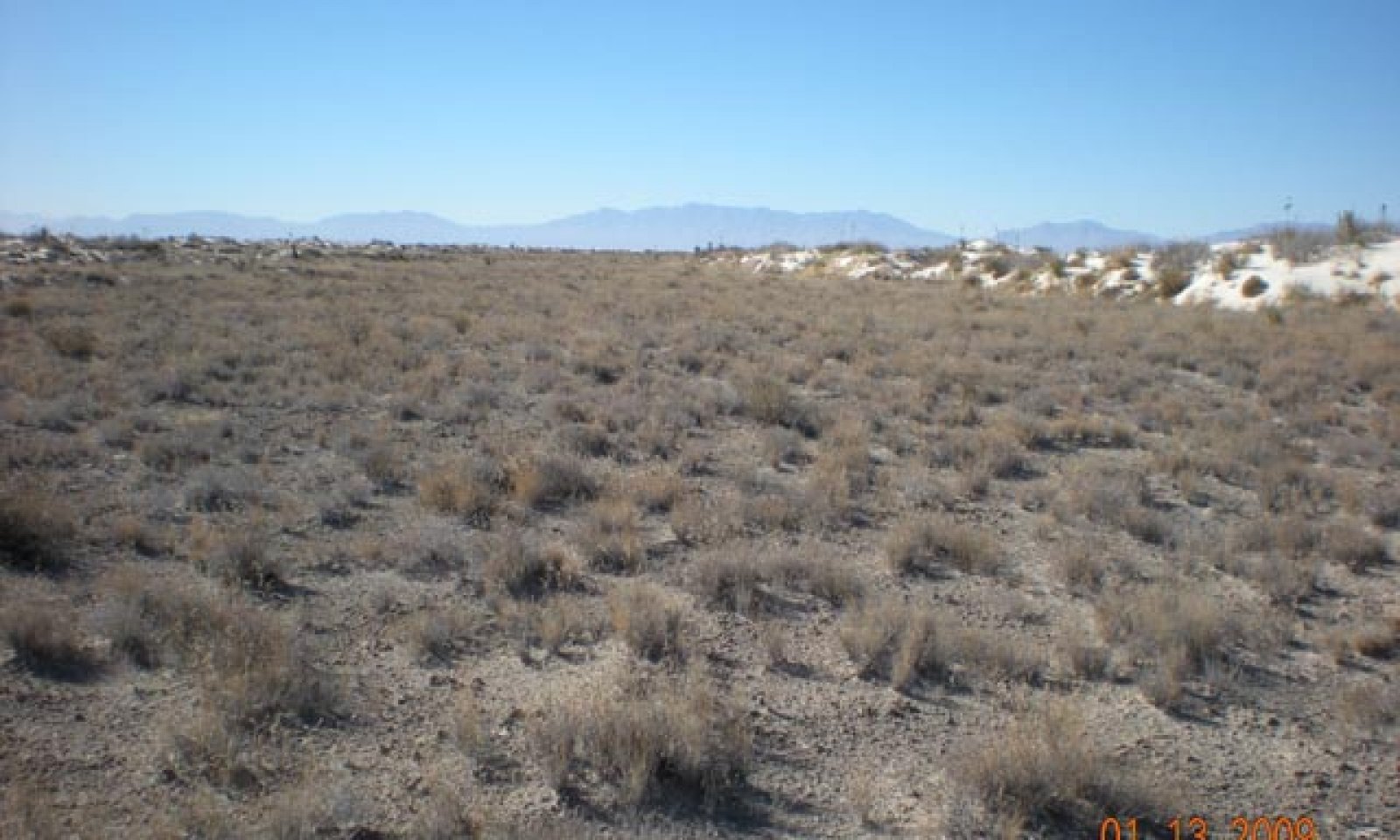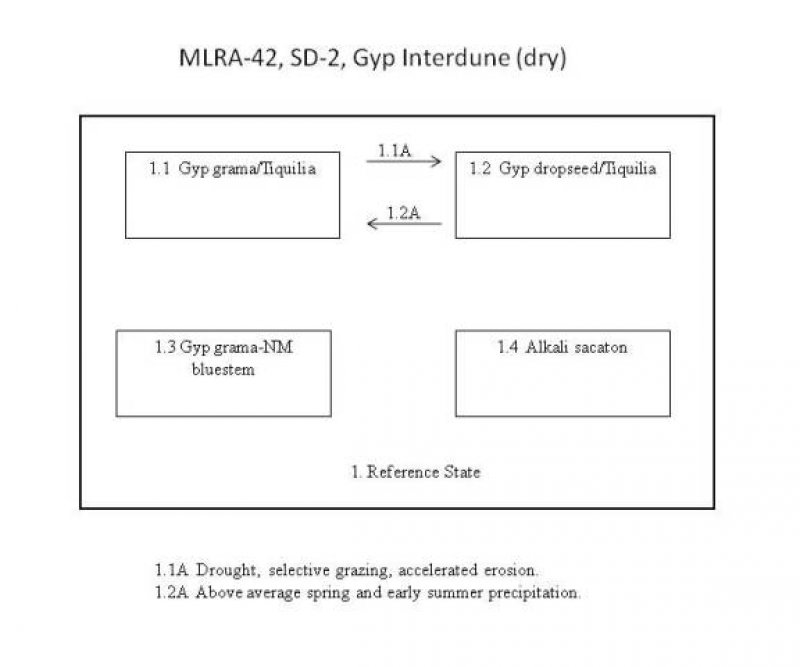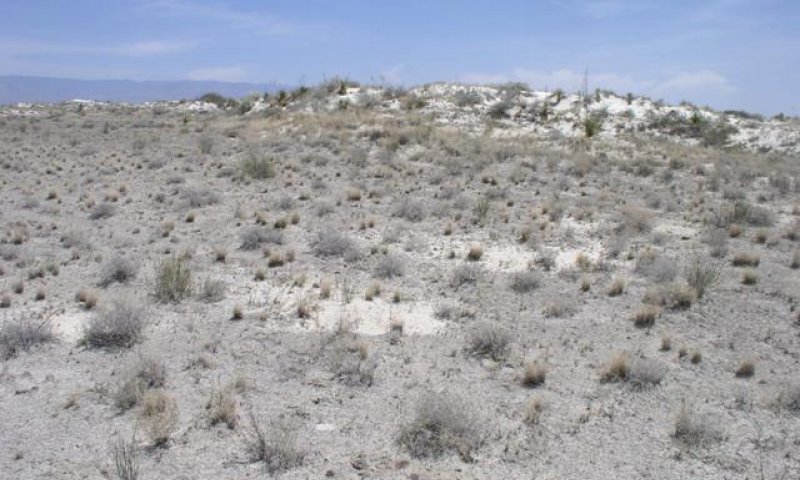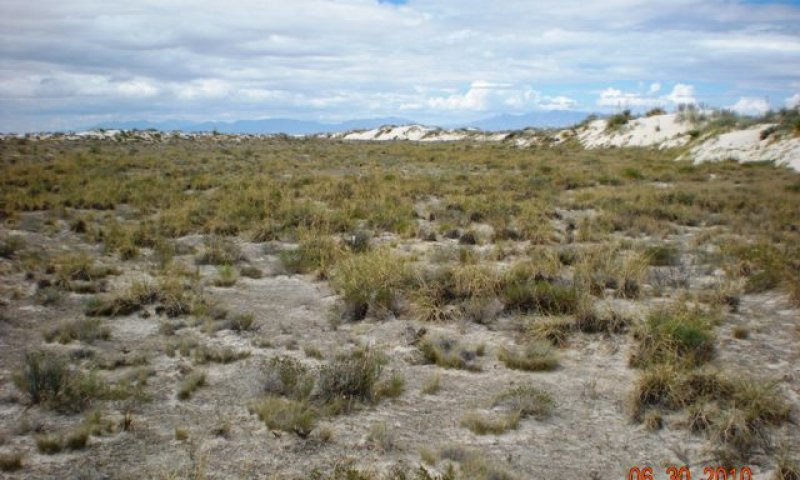

Natural Resources
Conservation Service
Ecological site R042BB005NM
Gyp Interdune (Dry), Desert Shrub
Accessed: 12/22/2024
General information
Provisional. A provisional ecological site description has undergone quality control and quality assurance review. It contains a working state and transition model and enough information to identify the ecological site.
Figure 1. Mapped extent
Areas shown in blue indicate the maximum mapped extent of this ecological site. Other ecological sites likely occur within the highlighted areas. It is also possible for this ecological site to occur outside of highlighted areas if detailed soil survey has not been completed or recently updated.
Associated sites
| R042BB003NM |
Vegetated Gypsum Dunes, Desert Shrub This site occurs in a complex with the Vegetated Gypsum dunes site. Vegetation composition and production on the interdune is influenced by proximity to the base of the associated dune. |
|---|
Table 1. Dominant plant species
| Tree |
Not specified |
|---|---|
| Shrub |
Not specified |
| Herbaceous |
Not specified |
Physiographic features
This site occurs as the interdunal areas within the parabolic dunefields. The trough-like interdune is a mixture of lower lying areas and small low relict stabilized dunes. The interdune is flanked by the larger active parabolic dunes. Elevation ranges from approximately 3900 to 4200 feet above sea level. Slope of the interdune landform averages 1 to 3 percent. However, slopes of the low relict stabilized dunes averages 1 to 10 percent.
Table 2. Representative physiographic features
| Landforms |
(1)
Interdune
|
|---|---|
| Flooding frequency | None |
| Ponding frequency | None |
| Elevation | 1,189 – 1,280 m |
| Slope | 1 – 10% |
| Water table depth | 127 – 183 cm |
| Aspect | Aspect is not a significant factor |
Climatic features
Annual average precipitation ranges from 7 to 12 inches. Wide fluctuations from year to year are common. At least one-half of the annual precipitation comes in the form of rainfall during July, August, and September. Precipitation in the form of snow or sleet averages less than 4 inches annually. The average annual air temperature is about 60 degree F. Summer maximums can exceed 100 degrees F. and winter minimums can go below zero. The average frost-free season exceeds 200 days and extends from April 1 to November 1. Both the temperature regime and rainfall distribution favor warm-season perennial plants on this site. Spring moisture conditions are only occasionally adequate to cause significant growth during this period of year. High winds from the west and southwest are common from March to June, which further tends to create poor soil moisture conditions in the springtime
Climate data was obtained from
http://www.wrcc.dri.edu/summary/climsmnm.html
Table 3. Representative climatic features
| Frost-free period (average) | 205 days |
|---|---|
| Freeze-free period (average) | 227 days |
| Precipitation total (average) | 305 mm |
Figure 2. Monthly precipitation range
Figure 3. Monthly average minimum and maximum temperature
Influencing water features
This site is not affected by water from wetland or stream.
Soil features
The soils on these sites are gypsiferous sandy eolian deposits overlain by high cover of dark colored biological crusts. Gypsum is present in high amounts (60-90 %) throughout the soil profile. Surface and underlying soils of the low stabilized dunes are gypsiferous sand. The lower lying interdune areas are gypsiferous very fine sandy loams over gypsiferous sand. The soils of this site are excessively drained and exhibit rapid permeability.
Characteristic Soils:
NM-688 MU-422 Astrobee-Lark Association, 0-35 percent slopes.
Table 4. Representative soil features
| Parent material |
(1)
Eolian deposits
–
rock gypsum
|
|---|---|
| Surface texture |
(1) Gypsiferous sand |
| Family particle size |
(1) Sandy |
| Drainage class | Excessively drained |
| Permeability class | Moderate |
| Soil depth | 203 cm |
| Surface fragment cover <=3" | 0% |
| Surface fragment cover >3" | 0% |
| Available water capacity (0-101.6cm) |
10.16 – 13.46 cm |
| Calcium carbonate equivalent (0-101.6cm) |
1 – 3% |
| Electrical conductivity (0-101.6cm) |
2 – 5 mmhos/cm |
| Soil reaction (1:1 water) (0-101.6cm) |
7.9 – 8.4 |
| Subsurface fragment volume <=3" (Depth not specified) |
0% |
| Subsurface fragment volume >3" (Depth not specified) |
0% |
Ecological dynamics
Overview: Plant community composition, distribution, and production within the interdune, are controlled by numerous factors. Some of which include the depth to ground water, quality of water, salinity level, and the effects of wind. Many of these factors are related. Where the ground water level is a little deeper and the surface soils are above the capillary fringe, water that infiltrates and remains in the pore spaces available for plants is not contaminated by the deeper saline ground water. These freshwater lenses may affect production and composition across segments of the interdune. Parabolic dunes like other dunes move in space over time. While the arms of the dune are partially stabilized by vegetation the center of the dune migrates fastest directed by the wind. Various communities may result due to these ongoing changing conditions within the associated interdune.
State and transition model

More interactive model formats are also available.
View Interactive Models
More interactive model formats are also available.
View Interactive Models
Click on state and transition labels to scroll to the respective text
Ecosystem states
State 1 submodel, plant communities
State 1
Grass/Shrub
This state is characterized by several different plant communities.
Community 1.1
Gyp grama/Tiquilia

Figure 4. Gyp grama/Tiquilia
This community is dominated by gyp grama and tiquilia. NM bluestem is usually sparse. Other species typically include ephedra, soaptree yucca, frosted mint, gyp dropseed and sand verbena. Cryptobiotic cover is typically high averaging 50 percent. This community can be fairly productive.
Figure 5. Annual production by plant type (representative values) or group (midpoint values)
Table 5. Annual production by plant type
| Plant type | Low (kg/hectare) |
Representative value (kg/hectare) |
High (kg/hectare) |
|---|---|---|---|
| Grass/Grasslike | 179 | 336 | 488 |
| Shrub/Vine | 112 | 280 | 347 |
| Forb | 28 | 56 | 73 |
| Total | 319 | 672 | 908 |
Table 6. Ground cover
| Tree foliar cover | 0% |
|---|---|
| Shrub/vine/liana foliar cover | 5-15% |
| Grass/grasslike foliar cover | 15-20% |
| Forb foliar cover | 2-5% |
| Non-vascular plants | 0% |
| Biological crusts | 25-70% |
| Litter | 15-25% |
| Surface fragments >0.25" and <=3" | 0% |
| Surface fragments >3" | 0% |
| Bedrock | 0% |
| Water | 0% |
| Bare ground | 5-20% |
Community 1.2
Gyp dropseed/Tiquilia

Figure 6. Gyp dropseed/Tiquilia

Figure 7. Firebee Pit
This community is dominated by gyp dropseed and tiquilia. Other species include ephedra, gyp grama, gyp moonpod, and gyp phacelia. This is the least productive community and plant cover is typically sparse. If gyp grama is present it typically is densest near the edges of the interdune approaching the base of the parabolic dunes.
Community 1.3
Gyp grama-NM bluestem

Figure 8. Gyp grama-NM bluestem
This community is a dominated by gyp grama and NM bluestem. The sub-shrub hairy crinklemat (Tiquilia hispidissima) is present in varying amounts. This community tends to occur on areas that exhibit depositional loose sands on the surface. One idea is these areas have more available soil moisture, and that the loose sands and increased moisture favor seed contact and germination. In the Tularosa basin, New Mexico bluestem is limited in extent by available water. Precipitation in the area barely meets minimal requirements. Recurring drought and to some extent selective grazing may effect a community change resulting in a decrease or absence of NM bluestem. Gyp grama has an advantage in reproductive capability, being able to reproduce both vegetatively and from seed.
Community 1.4
Alkali sacaton

Figure 9. Alkali sacaton
This community is dominated by alkali sacaton. Other species typically include varying amounts of gyp grama, gyp dropseed, tiquilia, frankennia, fourwing saltbush, rabbitbrush, and Hartweg’s sundrops. This community may occur where soils exhibit a increase in salinity such as areas adjacent to the barchanoid dune/interdunes.
Pathway 1.1A
Community 1.1 to 1.2


The various plant communities that occur on this site naturally are believed to result from differences in quality and depth to ground water, salinity level and wind pattern erosional force. Alternatively, areas that are subjected to drought and heavy grazing pressure by wildlife and or livestock may shift the community to a less productive gyp dropseed/ tiquilia community.
Pathway 1.2A
Community 1.2 to 1.1


Above average spring and early summer precipitation combined with proper grazing use may help to shift the community composition back to the more productive gyp grama/tiquilia community.
Additional community tables
Table 7. Community 1.1 plant community composition
| Group | Common name | Symbol | Scientific name | Annual production (kg/hectare) | Foliar cover (%) | |
|---|---|---|---|---|---|---|
|
Grass/Grasslike
|
||||||
| 1 | Warm Season Short Grasses | 168–448 | ||||
| gypsum grama | BOBR | Bouteloua breviseta | 168–448 | – | ||
| gyp dropseed | SPNE | Sporobolus nealleyi | 28–112 | – | ||
| 2 | Cool Season short grass | 0–11 | ||||
| 3 | Warm Season mid-grasses | 11–28 | ||||
| little bluestem | SCSCS | Schizachyrium scoparium var. scoparium | 6–17 | – | ||
| alkali sacaton | SPAI | Sporobolus airoides | 6–17 | – | ||
| spike dropseed | SPCO4 | Sporobolus contractus | 0–11 | – | ||
| mesa dropseed | SPFL2 | Sporobolus flexuosus | 0–11 | – | ||
|
Forb
|
||||||
| 4 | Perennial forbs | 17–56 | ||||
| White Sands fanmustard | NELI | Nerisyrenia linearifolia | 11–22 | – | ||
| woolly paperflower | PSTA | Psilostrophe tagetina | 3–17 | – | ||
| purple sand verbena | ABAN | Abronia angustifolia | 6–17 | – | ||
| hoary tansyaster | MACA2 | Machaeranthera canescens | 3–17 | – | ||
| sand fiddleleaf | NACA | Nama carnosum | 0–8 | – | ||
| Hartweg's sundrops | CAHA14 | Calylophus hartwegii | 0–6 | – | ||
| greenthread | THELE | Thelesperma | 0–6 | – | ||
| 5 | Annual forb | 11–17 | ||||
| Forb, annual | 2FA | Forb, annual | 6–17 | – | ||
| whitestem blazingstar | MEAL6 | Mentzelia albicaulis | 6–17 | – | ||
|
Shrub/Vine
|
||||||
| 6 | Sub-shrubs | 84–280 | ||||
| hairy crinklemat | TIHI | Tiquilia hispidissima | 84–280 | – | ||
| James' seaheath | FRJA | Frankenia jamesii | 0–56 | – | ||
| lanceleaf moonpod | SELA3 | Selinocarpus lanceolatus | 6–39 | – | ||
| broom snakeweed | GUSA2 | Gutierrezia sarothrae | 6–17 | – | ||
| southern goldenbush | ISPL | Isocoma pluriflora | 0–17 | – | ||
| 7 | Shrubs | 22–56 | ||||
| Torrey's jointfir | EPTO | Ephedra torreyana | 22–56 | – | ||
| Trans-Pecos false clapdaisy | PSAR | Pseudoclappia arenaria | 0–17 | – | ||
| frosted mint | POIN3 | Poliomintha incana | 0–6 | – | ||
| 8 | Succulents | 6–11 | ||||
| tulip pricklypear | OPPH | Opuntia phaeacantha | 6–11 | – | ||
| soaptree yucca | YUEL | Yucca elata | 6–11 | – | ||
Interpretations
Animal community
Characteristic wildlife includes little striped whiptail, White Sands prairie lizard, bleached earless lizard, spadefoot toad, Apache pocket mouse, White sands woodrat, spotted ground squirrel, camel cricket, tiger beetle, lycosid spider, and scorpions. Ord’s kangaroo rat and spotted ground squirrel.
Recreational uses
This site has potential for camping, hiking, and picnicking. Photography and bird watching for numerous birds, raptors and others can be fair to good, especially during migration seasons. Most small animals of the site are nocturnal and secretive, seen only at night, early morning or evening. Scenic beauty is greatest during spring and sometimes summer months when flowering of forbs, shrubs, and yucca occurs.
Wood products
This site has no significant value for wood products.
Other products
Gypsum
Supporting information
Inventory data references
Data collection for this site was done in conjunction with the progressive soil surveys within the Southern Desertic Basins, Plains and Mountains, Major Land Resource Areas of New Mexico. This site has been mapped and correlated with soils in the following soil surveys. White Sands Missile Range, White Sands National Monument.
Other references
Bennett, J., Wilder, D., 2009. Physical resources foundation report, White Sands National Monunent, Natural Resource Report NPS/NRPC/NRR—2009/166. National Park Service, Fort Collins, Colorado.
Fryberger, S.G., 2000. Geological overview of White Sands National Monument. http://www.nature.nps.gov/geology/parks/whsa/geows/index.htm
Langford, R.P., Rose, J.M., White, D.E., 2009. Groundwater salinity as a control on development of eolian landscape: An example from White Sands of New Mexico. Geomorphology 105(2009) 39-49.
Muldavin, E., Chauvin, Y., Harper, G., 2000 The Vegetation of White Sands Missile Range, New Mexico. Volume 1: Handbook of Vegetation Communities. Final Report, New Mexico Natural Heritage Program. University of New Mexico. Albuquerque, New Mexico.
Muldavin, E., Harper, G., Neville, P., Chauvin, Y., 2000 The Vegetation of White Sands Missile Range, New Mexico. Volume II: Vegetation Map. Final Report, New Mexico Natural Heritage Program. University of New Mexico. Albuquerque, New Mexico.
Contributors
David Trujillo
Rangeland health reference sheet
Interpreting Indicators of Rangeland Health is a qualitative assessment protocol used to determine ecosystem condition based on benchmark characteristics described in the Reference Sheet. A suite of 17 (or more) indicators are typically considered in an assessment. The ecological site(s) representative of an assessment location must be known prior to applying the protocol and must be verified based on soils and climate. Current plant community cannot be used to identify the ecological site.
| Author(s)/participant(s) | |
|---|---|
| Contact for lead author | |
| Date | |
| Approved by | |
| Approval date | |
| Composition (Indicators 10 and 12) based on | Annual Production |
Indicators
-
Number and extent of rills:
-
Presence of water flow patterns:
-
Number and height of erosional pedestals or terracettes:
-
Bare ground from Ecological Site Description or other studies (rock, litter, lichen, moss, plant canopy are not bare ground):
-
Number of gullies and erosion associated with gullies:
-
Extent of wind scoured, blowouts and/or depositional areas:
-
Amount of litter movement (describe size and distance expected to travel):
-
Soil surface (top few mm) resistance to erosion (stability values are averages - most sites will show a range of values):
-
Soil surface structure and SOM content (include type of structure and A-horizon color and thickness):
-
Effect of community phase composition (relative proportion of different functional groups) and spatial distribution on infiltration and runoff:
-
Presence and thickness of compaction layer (usually none; describe soil profile features which may be mistaken for compaction on this site):
-
Functional/Structural Groups (list in order of descending dominance by above-ground annual-production or live foliar cover using symbols: >>, >, = to indicate much greater than, greater than, and equal to):
Dominant:
Sub-dominant:
Other:
Additional:
-
Amount of plant mortality and decadence (include which functional groups are expected to show mortality or decadence):
-
Average percent litter cover (%) and depth ( in):
-
Expected annual annual-production (this is TOTAL above-ground annual-production, not just forage annual-production):
-
Potential invasive (including noxious) species (native and non-native). List species which BOTH characterize degraded states and have the potential to become a dominant or co-dominant species on the ecological site if their future establishment and growth is not actively controlled by management interventions. Species that become dominant for only one to several years (e.g., short-term response to drought or wildfire) are not invasive plants. Note that unlike other indicators, we are describing what is NOT expected in the reference state for the ecological site:
-
Perennial plant reproductive capability:
Print Options
Sections
Font
Other
The Ecosystem Dynamics Interpretive Tool is an information system framework developed by the USDA-ARS Jornada Experimental Range, USDA Natural Resources Conservation Service, and New Mexico State University.
Click on box and path labels to scroll to the respective text.